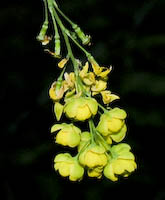European Barberry
Berberis vulgaris |
 Other common names:
Common Barberry Other common names:
Common Barberry

French names:
╔pine-vinette commune

Family:
Barberry Family (Berberidaceae)

Group:
Barberries

Distinctive features:
Shrub; Yellowish wood. Sharp 3-pronged spines. Obovate leaves. Fruits in bunches hanging down.

Similar species:
•
Japanese Barberry (Berberis thunbergii) - very similar.
•
American Barberry (Berberis canadensis) - not in Ontario.

Flowers:
Summer; Yellow; 6 parts (petals); Small, yellow, in drooping clusters.

Leaves:
Alternate, Simple, Toothed; Obovate leaves. Prominently spiny-toothed.

Height:
2-3 m (6-9 ft)

Trunk:
Wood is yellowish inside.

Fruit/Seeds:
In bunches hanging down.

Habitat:
Forests, Fields and Open Areas; Roadsides, fields, open areas, woods, thickets.

Books:
Newcomb's Wildflower Guide: 354

Native/Non-native:
Non-native

Status:
Common, alien, invasive.

Notes:
European Barberry is an alien escapee from gardens.

Origin and Meaning of Names:
Scientific Name: vulgaris: common (Latin)

Photographs:
55 photographs available, of which 15 are featured on this page. SCROLL DOWN FOR PHOTOGRAPHS.

 |
 |
|
|
|
|
|
|
|
 |